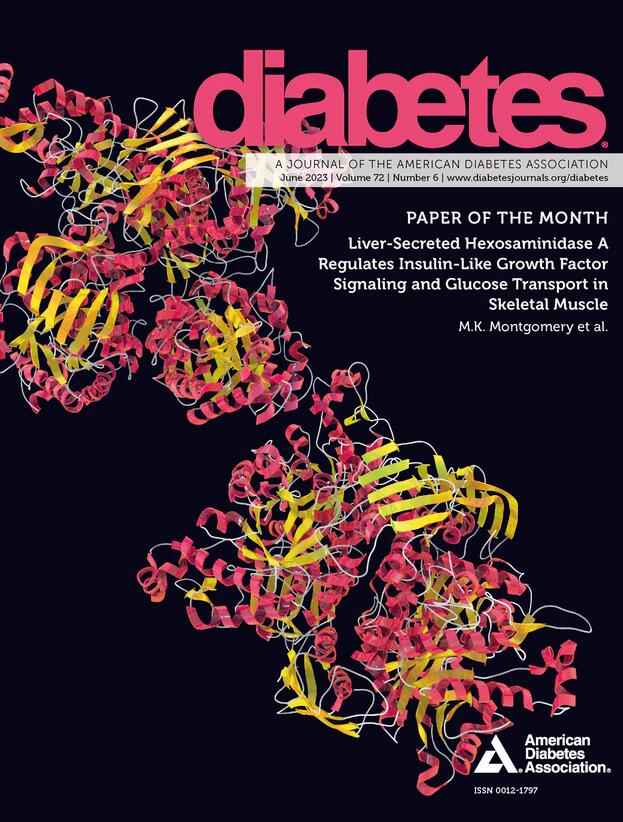719-P: Oral Disposition Index (oDI) as an Outcome Measure in Type 1 Diabetes (T1D) Clinical Trials—Evidence from Stage 1 and Stage 2 Trials
IF 6.2
1区 医学
Q1 ENDOCRINOLOGY & METABOLISM
引用次数: 0
Abstract
Introduction and Objective: Metabolic endpoints are being explored for treatment response in T1D prevention trials. Measures combining both insulin secretion and sensitivity could be more sensitive markers of treatment effect in clinical trials. Methods: We compared OGTT-derived AUC C-peptide and C-peptide index (CPI) as measures of secretion, and the oDI (AUC Insulin*Matsuda Index) as a measure of β-cell function including both secretion and sensitivity in two TrialNet trials in Stage 1 (TN18, Abatacept for 12 months) and Stage 2 (TN10, Teplizumab for 14 days) T1D. We compared measures over time and after 2 years of treatment between treated and placebo arms. Results: In TN10, Teplizumab had a greater effect on AUC C-peptide (p=0.008) and CPI (p<0.001) compared to placebo after 2 years; oDI did not differ (p=0.241). Conversely, in TN18, oDI was higher in the Abatacept arm compared to placebo (p<0.001) with no differences in AUC C-peptide (p=0.270) and CPI (p=0.194). Further, in TN18, there was a positive change in oDI from baseline in the treated arm (p<0.001), Figure 1. Conclusion: The oDI appears to be more sensitive at detecting differences in Abatacept effect in Stage 1, while C-peptide measures identifies long-term effect of Teplizumab in Stage 2. This could be due to both secretion and sensitivity playing a stronger role in Stage 1, which is better seen over a longer period of time. Disclosure A. Galderisi: None. D.D. Cuthbertson: None. A. Petrelli: None. A. Moran: Research Support; Abbott. Consultant; Abata Therapeutics. Other Relationship; Novo Nordisk. J. Sosenko: None. L.M. Jacobsen: Advisory Panel; Sanofi. I. Libman: None. M.J. Redondo: None. H.M. Ismail: Consultant; Rise Therapeutics. Funding NIDDK (K23DK129799)口腔处置指数(oDI)作为1型糖尿病(T1D)临床试验的结局指标——来自1期和2期试验的证据
简介和目的:在T1D预防试验中,代谢终点正在探索治疗反应。在临床试验中,结合胰岛素分泌和胰岛素敏感性的指标可能是更敏感的治疗效果指标。方法:在两项TrialNet试验中,我们比较了ogtt衍生的AUC c肽和c肽指数(CPI)作为分泌指标,oDI (AUC胰岛素*Matsuda指数)作为β细胞功能的指标,包括分泌和敏感性,这两项试验分别为1期(TN18, Abatacept, 12个月)和2期(TN10, Teplizumab, 14天)T1D。我们比较了治疗组和安慰剂组随时间和治疗2年后的测量结果。结果:在TN10中,2年后与安慰剂相比,Teplizumab对AUC -肽(p=0.008)和CPI (p= 0.001)的影响更大;oDI差异无统计学意义(p=0.241)。相反,在TN18中,与安慰剂相比,Abatacept组的oDI更高(p<0.001),而AUC c肽(p=0.270)和CPI (p=0.194)无差异。此外,在TN18中,治疗组的oDI较基线呈阳性变化(p<0.001),图1。结论:oDI在1期检测Abatacept疗效差异方面似乎更敏感,而c肽测量在2期检测Teplizumab的长期疗效。这可能是由于分泌和敏感性在第一阶段发挥了更大的作用,这需要更长的时间才能更好地看到。A. Galderisi:没有。D.D. Cuthbertson:没有。A. Petrelli:没有。A. Moran:研究支持;阿伯特。顾问;Abata疗法。其他关系;诺和诺德公司。索森科:没有。L.M. Jacobsen:顾问小组;赛诺菲。李伯曼:没有。M.J.雷东多:没有。H.M. Ismail:顾问;治疗上升。资助NIDDK (K23DK129799)
本文章由计算机程序翻译,如有差异,请以英文原文为准。
求助全文
约1分钟内获得全文
求助全文
来源期刊

Diabetes
医学-内分泌学与代谢
CiteScore
12.50
自引率
2.60%
发文量
1968
审稿时长
1 months
期刊介绍:
Diabetes is a scientific journal that publishes original research exploring the physiological and pathophysiological aspects of diabetes mellitus. We encourage submissions of manuscripts pertaining to laboratory, animal, or human research, covering a wide range of topics. Our primary focus is on investigative reports investigating various aspects such as the development and progression of diabetes, along with its associated complications. We also welcome studies delving into normal and pathological pancreatic islet function and intermediary metabolism, as well as exploring the mechanisms of drug and hormone action from a pharmacological perspective. Additionally, we encourage submissions that delve into the biochemical and molecular aspects of both normal and abnormal biological processes.
However, it is important to note that we do not publish studies relating to diabetes education or the application of accepted therapeutic and diagnostic approaches to patients with diabetes mellitus. Our aim is to provide a platform for research that contributes to advancing our understanding of the underlying mechanisms and processes of diabetes.
 求助内容:
求助内容: 应助结果提醒方式:
应助结果提醒方式:


